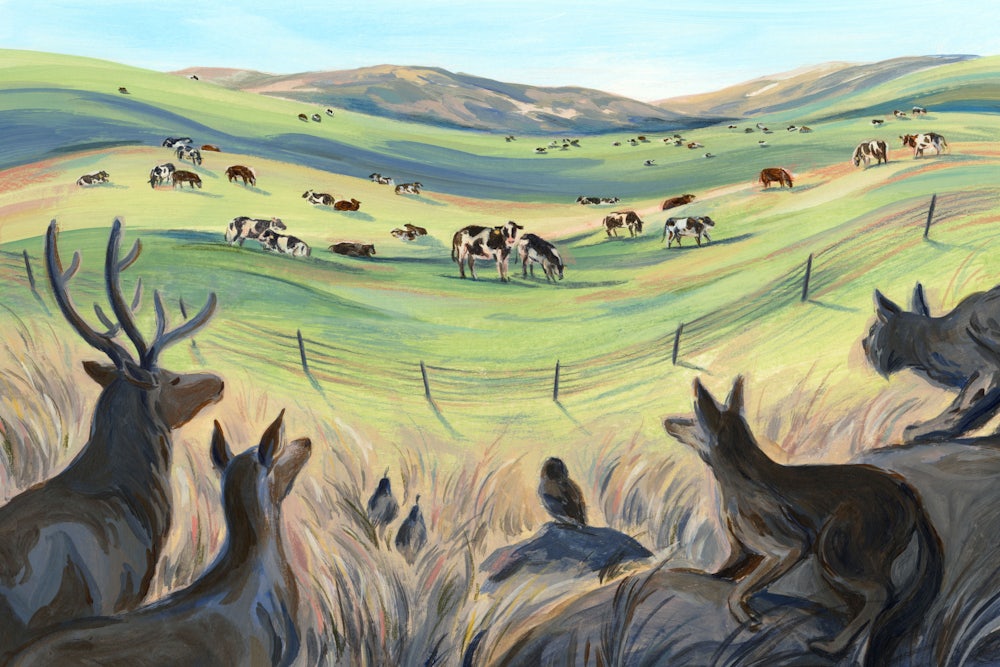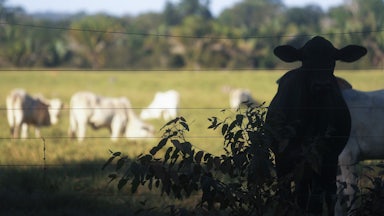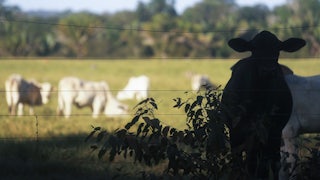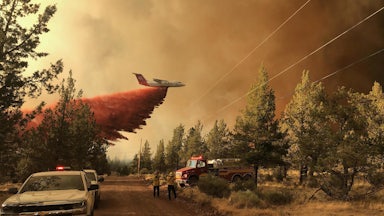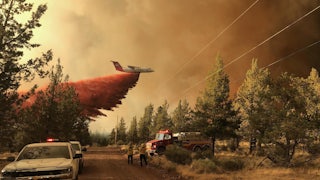When foodies sink their teeth into a slab of cheese from one of the historic dairy farms in Point Reyes, California, their minds probably run to grass-fed cows ranging free on the lush green oceanside hills of Marin County. Over 5,000 dairy cows and beef cattle roam the Point Reyes National Seashore National Park in full view of visiting tourists. Unlike the many dairy and meat companies that slap happy animals on their labels while sourcing their product from hellish factory farms, the dairy and beef farms at Point Reyes represent an agrarian ideal of ecologically and ethically sustainable animal agriculture.
“Pasture-raised” and “extensive” or “regenerative” grazing have been watchwords in the American foodie community since at least the 2000s, when celebrated food writer Michael Pollan presented sustainable, nonindustrial practices as a way out of the ethical morass of the American food system in his award-winning bestseller The Omnivore’s Dilemma. Everyone from progressive agrarians to libertarian ranchers to multinational food companies, and even conservation NGOs such as the Audubon Society, has thrown their weight behind the idea of replacing mass-produced meat, from chickens to ungulates, with a holistically raised alternative. While some environmentalists reject beef altogether for its contribution to climate change, pollution, and deforestation, proponents of free-ranging beef have rallied under the motto, “It’s not the cow; it’s the how.” They argue that, done properly, pasture-raised cattle can replace the ecological functions of wild ruminants like elk and bison, produce food on “marginal” land that would otherwise be wasted, and eliminate beef’s carbon hoofprint (since well-grazed land can sequester atmospheric carbon dioxide). This would mean consumers could stick it to Big Ag, fight climate change, and help imperiled animals and ecosystems without actually changing their diets too much; they’d just need to eat a bit less meat and pay a bit more for the grass-fed option.
Whether these promises hold up under scrutiny is a subject of fierce debate. And in recent years, a series of lawsuits have argued the opposite thesis: that even “regenerative” cattle imperil the very ecosystems proponents claim they will “regenerate.”
This past June, the Harvard Animal Law and Policy Clinic, on behalf of the Animal Legal Defense Fund and a number of individual plaintiffs, filed suit against the Department of the Interior and the National Park Service, which manages Point Reyes National Park, alleging that cattle ranching is endangering the iconic tule elk.* It’s not the first such lawsuit that has been filed over the past decade against the NPS to stop alleged environmental damage from Point Reyes cows.
The National Park Service leases parkland to a number of “historic” cattle and dairy farms, which it has done since the park’s creation in 1962. The elk, native to the region but driven to near-extinction by hunting and human activities such as ranching, are protected by a 1976 federal conservation law and were reintroduced to the park in 1978. But to keep the elk from competing with cattle for forage and water, the NPS erected fences that confine the elk to select corners of the park with limited water and forage. This confinement has proved fatal during droughts. Drought in 2013–2014 led to 254 elk deaths. A current drought has already killed over 150 elk, a third of the once 445-strong herd that inhabits Tomales Point, all just a stone’s throw away from thriving commodity cows. Ranchers have even pushed for the right to cull elk outright to keep their populations in check, in part because they have also killed off the natural predators that would do so in a healthy ecosystem. The Harvard suit alleges that “the Tule elk are continuing to die horrific and preventable deaths” in clear violation of federal law.
Prior to the twentieth century, the tule elk were an important part of the Pacific coastal ecosystem and a major component of the diet of the Coast Miwok tribe, the native peoples who lived there. In fact, the NPS concedes that the region’s characteristic hilly grasslands were “the byproduct of burning, weeding, pruning and harvesting for at least two millennia by Coast Miwok and their antecedents.” These grasslands made a juicy target for white settlers arriving in the middle of the nineteenth century. They brought cattle with them, plundered the Coast Miwok lands, hunted large predators and elk to near-extinction, and then grazed their cattle on the hills instead. The intertwined processes of colonial and ecological displacement have continued into the twenty-first century: In 2015, the NPS balked at a proposed “Indigenous Archaeological District” that would have protected Coast Miwok heritage sites from damage from ranching. Even as it did so, it quickly approved a “Historic Dairy Ranching District,” over and against Miwok protests. Today, many Coast Miwok are opposed to the rancher-backed plan to fence and further cull the elk. “The Park Service proposal to shoot indigenous tule elk and promote ranching that harms wildlife, water and habitat is a travesty and contrary to the traditions of our ancestors,” Jason Deschler, dance captain and headman with the Coast Miwok Tribal Council of Marin, wrote this summer in a statement opposing the cull.
The cows at Point Reyes don’t just compete with the elk. They also defecate about 130 million pounds of nitrogen-rich manure a year, which leaches into the soil and streams and ponds of the area. An NPS-funded study suggested that removal of the cows would benefit numerous native species, including butterflies, seabirds, frogs, and salmon. And yet the same study recommended the expansion of ranching. As a damning investigative report into the issue in the Marin County Pacific Sun suggests, the ranchers and dairy farmers have urged pliant politicians, including Senator Dianne Feinstein, to “pressur[e] the Park Service to prioritize the preservation of private ranching profits over environmental concerns.”
Point Reyes is a microcosm of a much broader anti-wildlife bent in American ranching, regenerative and otherwise. To protect their cows from predators and disease, or simply to ensure that they have access to food and water, ranchers across the country have supported wolf hunts, vulture and wild horse culls, and the deployment of cyanide bombs. It is difficult to count the number of wild animals killed in the service of ranching interests by government bodies like the Agriculture Department’s secretive Wildlife Services, the Bureau of Land Management, and various state-level farm bureaus, but about a million animals per year is the federal government’s own estimate.
Unlike wild animals such as elk, ranched cattle are commodities in a global market. And the goals of commodity production run directly counter to those of a functional ecosystem. In the wild, ungulates like bison or elk range across vast swathes of land, serving all sorts of ecosystem functions just by living: rooting, trampling, defecating, dying and decomposing, serving as food for predators and carrion birds and insects, nourishing other animals and the soil in death as their hooves did in life. Commodity production, be it conventional or regenerative, removes animals like cows from this web of life, using fencing and predator extermination to protect grazers from harm so that they can be profitably sold. In place of that natural web, ranching also requires an economic and material infrastructure to breed, manage, slaughter, process, and transport cattle as they are transformed into beef or milked. Even with the best of ecological intentions, ranchers who want their business to survive must build and maintain that infrastructure according to commercial principles.
The capitalist assumptions pervading these enterprises are clearest when regenerative proponents promise to be able to extract food from so-called “marginal” lands. Conventionally defined, “marginal land” is land that has little current agricultural or industrial value, often because of poor soil, water resources, or climate conditions. What ranchers mean is that grazing cattle can extract value, in the form of commoditized beef, from dry, rocky, difficult to access lands. Of course, such lands are only “marginal” from an instrumental, Lockean view that all land must be worked to create value. But from a biodiversity and ecosystem health perspective, so-called marginal lands can be thriving, biodiverse habitats for myriad flora and fauna, which can be disrupted by the introduction of grazers.
Historically, even land that is home to human beings has been deemed “marginal” if its value cannot be commoditized. As historian Joshua Specht shows, ranchers have historically been the spear tip of settler colonialism in the American West. They often used the pretext of “waste” and “emptiness” to violently uproot Indigenous lifeways and ecosystems and replace them with “productive” commercial ranching. The Coast Miwok Tribal Council of Marin linked that history of dispossession to the plan to cull the elk in a letter to Secretary of the Interior Deb Haaland, describing it as “a travesty … that perpetuates a long legacy of harm inflicted on Native People by the National Park Service.”
The idea of converting “marginal” or unused land is basically a promise to produce something from nothing. All too often, that simply means that the costs are hidden. Increasingly, environmental research suggests that while introducing grazers to marginal lands can be economically generative for those who own the grazers, it is degenerative of previously existing ecosystems. A recent meta-analysis in the journal Ecology Letters, for example, found that excluding commercial agricultural grazers increases the abundance of plant and faunal biodiversity in most ecosystems. That’s because most livestock are managed at densities that dramatically exceed those of wild fauna. In fact, the Center for Biological Diversity recently won a lawsuit that will force the Forest Service and the U.S. Fish and Wildlife Service to protect sensitive ecosystems within New Mexico’s Gila National Forest and Arizona’s Apache-Sitgreaves National Forest from free-ranging cows.
Over the past two decades, proponents of “regenerative” grazing have increasingly justified cattle agriculture by claiming their methods reduce ruminants’ contribution to climate change: Currently, the world’s cows, by belching out methane, contribute about 6 percent percent of all greenhouse gases. (Many note that cows “only” contribute 3 percent of U.S. emissions, but this is only because of America’s massive total emissions.) Regenerative ranching proponents claim, however, that by turning over and fertilizing the soil where they graze, free-ranging ruminants create healthy soil that can act as a carbon sink.
One of the biggest drivers of this claim has been the work of the rancher Allan Savory, made famous through a viral TED talk in 2013. But Savory’s claims have little peer-reviewed support and seem to fail under scrutiny. “The Savory Method Can Not Green Deserts or Reverse Climate Change,” five researchers argued in a lengthy rebuttal published in the journal Rangelands that same year. In 2017, an exhaustive, 127-page study led by scholars at Oxford found that grass-fed livestock “does not offer a significant solution to climate change as only under very specific conditions can they help sequester carbon. This sequestering of carbon is even then small, time-limited, reversible and substantially outweighed by the greenhouse gas emissions these grazing animals generate.”
Studies suggest that while some forms of well-managed grazing can increase the health and productivity of soil, there is little proof that this has much impact on soil’s ability to capture carbon. To the extent that soil can act as a carbon sink, a widely-cited article in Frontiers in Climate argues that it can do so through practices like cover crop rotation, tillage, and novel soil amendments that don’t use animals at all. But cows or no cows, the idea that soil can act as a meaningful carbon sink at the scale at which global climate change currently operates is itself not entirely convincing. Removing soil from any agricultural use and allowing it to rewild, however, can create meaningful carbon sinks while protecting and restoring biodiversity; wild elk populations might plausibly do more to capture carbon than the most holistically raised cattle.
When it comes to cows, there is actually a sort of perverse climate and ethical math at play. Most of America’s 93 million cattle spend at least some of their life grazing on pasture, although many beef cattle are also fattened for slaughter in feedlots where they are fed soy- and grain-based meals. But since processed meal is easier to digest and beef cattle, on average, spend only a few of their 18-month lives at feedlots, only about 11 percent of their greenhouse gas emissions happen there. The remaining 89 percent happen when they digest rough forage and grasses on pasture. In other words, cows that graze throughout their lives actually potentially emit more than feedlot-finished ones.
Small numbers of grazers may be consistent with healthy ecosystems and have minimal greenhouse gas impact, but only if their populations stay within ecologically defined limits. The situation in Point Reyes, where ranchers have pushed the NPS to be able to use more land for grazing and prevent elk from competing with cows for food and water, illustrates exactly why that’s unlikely.
The problem of scale bedevils regenerative beef from every angle. Holistic grazing cannot hope to compete on price with Big Meat, which operates with high volumes and low margins: A pound of ground beef from a Marin County ranch can run well over $10, compared to $3.99 for mass-produced beef at Kroger. Regenerative ranching proponents often answer that consumers will opt to eat “less but better meat,” but it’s far from clear what’s going to drive that transition at the societal level. (Also worth noting: In the absence of a public agency that could define and regulate ecologically informed grazing practices, “better” meat is a little nebulous. The “regenerative” label has been affixed to so many different techniques that what exactly it means is often hard to pin down.)
As a result, “regenerative” beef currently represents not so much a scalable climate solution as a way for those who can afford to do so to purchase indulgences for their continued meat consumption. The owners of grass-fed beef ventures may market their premium-priced products as a way out of the hellscape of Western capitalistic agriculture. But absent much broader societal changes, regenerative agriculture’s anti-industrial rhetoric is more of a class marker than a call to revolution.
If regenerative agriculture were to challenge the mainstream food system, it would run into some hard physical limits. Converting the beef industry, at current levels of demand, entirely to a grass- and crop-forage feeding system would require increasing the total size of American beef herds by 23 million cows, or 30 percent, according to a recent article in the respected science journal Environmental Research Letters. And that increase, were it even possible, would have monumental consequences for both greenhouse gas outputs and land use. But there simply isn’t enough land in the U.S. for that many grazers. At best, beef production would have to decrease by 39 percent and potentially as much as 73 percent. Framed that way, grass-fed grazing, especially if scaled, doesn’t seem likely to regenerate many ecosystems—indeed, it would likely require deforestation, as is the case in Brazil, where the clear-cutting of the Amazon is driven both by soy plantations for feedlot and factory farm animal feed and by the need for grazing space for grass-fed cattle. And as the Environmental Research Letters article argued, even temporary overgrazing can lead to long-term and perhaps irreversible ecological degradation.
This list of mismatches between theory and empirics prompts an important question: Who does benefit from more demand for holistic-grazed beef? Ranchers and dairy farmers, of course. Regenerative ranching begins with the assumption that cattle must be commercially ranched and then backfills an ecological narrative to sustain that assumption, much as the NPS assumes there must be ranches in Point Reyes and then reshapes the park’s history and landscape to fit that need.
Actually making animal agriculture less ecologically disruptive would mean taking animals’ ecological value as a bedrock principle against and over their value as commodities. That means treating commodity production, not land, as “marginal”: Commodities could be extracted only if doing so didn’t disturb the ecological, social, and cultural value of the landscape. In other words, in most such systems, animals would more than likely play a minor support role for primarily plant agriculture. And that, in turn, would almost certainly mean far fewer grazers entering the commercial food system, and at a much higher price point. Point Reyes, for example, might feature free-ranging elk managed by an Indigenous best practice–driven conservation agency, not dairy cattle grazed by private ranches. This kind of truly eco-friendly meat production would produce even less meat than the current grab bag of practices loosely labeled “regenerative.”
As the elk of Point Reyes might attest, grass-fed beef and dairy are not ecologically benign. Nor are they a solution to climate change. Nor yet, in offering a more expensive alternative to industrial agriculture to those who can afford it, do they offer a clear path for reducing meat consumption society-wide. If anything, regenerative ranching lends itself either to niche locavore indulgence or large-scale corporate greenwashing, but it offers little promise for sustainable food system transformation.
Achieving more sustainable agriculture means we need to produce and eat less meat. To get there, we’ll need individuals to change their habits, but we’ll also need policy aimed specifically at reducing meat consumption through taxation, nudges toward animal-free diets, or, potentially, support for the proliferation of plant- or cell-based meat analogs. Ranchers tend to deny this, not because it is ecologically unfounded but because they are financially invested in ranching rather than regeneration.
*One of the authors of this piece is a fellow at the Harvard Animal Law and Policy Program. He is not and has never been personally involved in the Point Reyes lawsuit.
